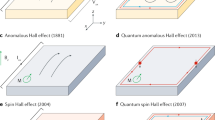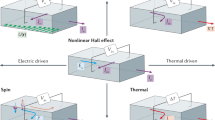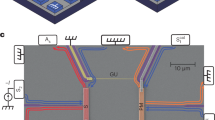Abstract
The magneto-resistance of high-mobility two-dimensional electron systems exposed to microwaves exhibits radiation-induced oscillations with some minima approaching zero within experimental accuracy. Consensus has been reached that they originate from disorder-assisted indirect optical transitions and a non-equilibrium population of the electronic states. Both mechanisms capture the hall-marks of the observed oscillations except for the appearance of zero resistance. Theory has predicted that in the minima the resistivity can become negative. Then a homogeneous system turns unstable and current domains with large internal Hall electric fields pointing in opposite directions spontaneously form to produce zero resistance. Direct evidence for such domains has remained elusive. Here we introduce time as an unexplored parameter. Probing internal Hall voltages reveals random telegraph signals in the zero-resistance regime. They provide compelling evidence for spontaneous switching between two different distributions of the electric field, which is attributed to two distinct current domain configurations.
This is a preview of subscription content, access via your institution
Access options
Subscribe to this journal
Receive 12 print issues and online access
$209.00 per year
only $17.42 per issue
Buy this article
- Purchase on Springer Link
- Instant access to full article PDF
Prices may be subject to local taxes which are calculated during checkout





Similar content being viewed by others
References
Zudov, M. A., Du, R. R., Simmons, J. A. & Reno, J. L. Shubnikov–de Haas-like oscillations in millimeter wave photoconductivity in a high-mobility two-dimensional electron gas. Phys. Rev. B 64, 201311 (2001).
Ye, P. D. et al. Giant microwave photoresistance of two-dimensional electron gas. Appl. Phys. Lett. 79, 2193–2195 (2001).
Mani, R. G. et al. Zero-resistance states induced by electromagnetic-wave excitation in GaAs/AlGaAs heterostructures. Nature 420, 646–650 (2002).
Zudov, M. A., Du, R. R., Pfeiffer, L. N. & West, K. W. Evidence for a new dissipationless effect in 2D electronic transport. Phys. Rev. Lett. 90, 046807 (2003).
Andreev, A. V., Aleiner, I. L. & Millis, A. J. Dynamical symmetry breaking as the origin of the zero-d.c.-resistance state in an a.c.-driven system. Phys. Rev. Lett. 91, 056803 (2003).
Inarrea, J. & Platero, G. Theoretical approach to microwave-radiation-induced zero-resistance states in 2D electron systems. Phys. Rev. Lett. 94, 016806 (2005).
Auerbach, A., Finkler, A. I., Halperin, B. I. & Yacoby, A. Steady states of a microwave-irradiated quantum-Hall gas. Phys. Rev. Lett. 94, 196801 (2005).
Alicea, J., Balents, L., Fisher, M. P. A., Paramekanti, A. & Radzihovsky, L. Transition to zero resistance in a two-dimensional electron gas driven with microwaves. Phys. Rev. B 71, 235322 (2005).
Finkler, I., Halperin, B.I., Auerbach, A. & Yacoby, A. Domain patterns in the microwave-induced zero-resistance state. J. Stat. Phys. 125, 1093–1107 (2006).
Finkler, I. G. & Halperin, B. I. Microwave-induced zero-resistance states are not necessarily static. Phys. Rev. B 79, 085315 (2009).
Ryzhii, V. I. Photoconductivity characteristics in thin films subjected to crossed electric and magnetic fields. Phiz. Tverd. Tela 11, 2577–2579 (1969); Sov. Phys.—Solid State 11, 2078–2080 (1970).
Ryzhii, V. I., Suris, R. A. & Shchamkhalova, B. S. Photoconductivity of a two-dimensional electron gas in a strong magnetic field. Fiz. Tekh. Poluprov. 20, 2078–2083 (1986); Sov. Phys. Semicond. 20, 1299–1302 (1987).
Durst, A. C., Sachdev, S., Read, N. & Girvin, S. M. Radiation-induced magnetoresistance oscillations in a 2D electron gas. Phys. Rev. Lett. 91, 086803 (2003).
Vavilov, M. G. & Aleiner, I. L Magnetotransport in a two-dimensional electron gas at large filling factors. Phys. Rev. B 69, 035303 (2004).
Dorozhkin, S. I. Giant magnetoresistance oscillations caused by cyclotron resonance harmonics. Pis. Zh. Eksp. Teor. Fiz. 77, 681–685 (2003); JETP Lett. 77, 577–581 (2003).
Dmitriev, I. A., Vavilov, M. G., Aleiner, I. L., Mirlin, A. D. & Polyakov, D. G. Theory of microwave-induced oscillations in the magnetoconductivity of a two-dimensional electron gas. Phys. Rev. B 71, 115316 (2005).
Dmitriev, I. A., Mirlin, A. D. & Polyakov, D. G. Microwave photoconductivity of a two-dimensional electron gas: Mechanisms and their interplay at high radiation power. Phys. Rev. B 75, 245320 (2007).
Dmitriev, I. A., Khodas, M., Mirlin, A. D., Polyakov, D. G. & Vavilov, M. G. Mechanisms of the microwave photoconductivity in two-dimensional electron systems with mixed disorder. Phys. Rev. B 80, 165327 (2009).
Zakharov, A. L. Instability in a semiconductor amplifier with negative effective carrier mass. Zh. Eksp.Teor. Fiz. 38, 665–667 (1960);Sov. Phys. JETP 11, 478–479 (1960).
Gunn, J. B. Microwave oscillations of current in III–V semiconductors. Solid State Commun. 1, 88–91 (1963).
Zudov, M. A., Du, R. R., Pfeiffer, L. N. & West, K. W. Bichromatic microwave photoresistance of a two-dimensional electron system. Phys. Rev. Lett. 96, 236804 (2006).
Durst, A. C. Resistance is futile. Nature 442, 752–753 (2006).
Inarrea, J. & Platero, G. From zero resistance states to absolute negative conductivity in microwave irradiated two-dimensional electron systems. Appl. Phys. Lett. 89, 052109 (2006).
Willett, R. L., Pfeiffer, L. N. & West, K. W. Evidence for current-flow anomalies in the irradiated 2D electron system at small magnetic fields. Phys. Rev. Lett. 93, 026804 (2004).
Zudov, M. A., Du, R. R., Pfeiffer, L. N. & West, K. W. Multiphoton processes in microwave photoresistance of two-dimensional electron systems. Phys. Rev. B 73, 041303 (2006).
Bykov, A. A., Islamov, D. R., Nomokonov, D. V. & Bakarov, A. K. Absolute negative resistance in a nonequilibrium two-dimensional electron system in a strong magnetic field. Pis. Zh. Eksp. Teor. Fiz. 86, 695–698 (2007); JETP Lett. 86, 608–611 (2007).
Bykov, A. A. Spatial inhomogeneity of the microwave-induced electronic states with zero conductivity in Corbino disks at high filling factors. Pis. Zh. Eksp. Teor. Fiz. 91, 390–394 (2010); JETP Lett. 91, 361–364 (2010).
Dorozhkin, S. I. et al. Photocurrent and photovoltage oscillations in the two-dimensional electron system: Enhancement and suppression of built-in electric fields. Phys. Rev. Lett. 102, 036602 (2009).
Dmitriev, I. A., Dorozhkin, S. I. & Mirlin, A. D. Theory of microwave-induced photocurrent and photovoltage magneto-oscillations in a spatially nonuniform two-dimensional electron gas. Phys. Rev. B 80, 125418 (2009).
Auerbach, A. & Pai, G. V. Nonlinear current of strongly irradiated quantum Hall gas. Phys. Rev. B 76, 205318 (2007).
Acknowledgements
We acknowledge financial support from the German Ministry of Science and Education (BMBF) and (S.I.D.) the Russian foundation for basic research.
Author information
Authors and Affiliations
Contributions
S.I.D. and J.H.S. contributed to all aspects of the work. L.P. and K.W. provided samples. K.v.K. commented on the manuscript.
Corresponding author
Ethics declarations
Competing interests
The authors declare no competing financial interests.
Supplementary information
Supplementary Information
Supplementary Information (PDF 747 kb)
Rights and permissions
About this article
Cite this article
Dorozhkin, S., Pfeiffer, L., West, K. et al. Random telegraph photosignals in a microwave-exposed two-dimensional electron system. Nature Phys 7, 336–341 (2011). https://doi.org/10.1038/nphys1895
Received:
Accepted:
Published:
Issue Date:
DOI: https://doi.org/10.1038/nphys1895
This article is cited by
-
Photo-oscillations in MgZnO/ZnO heterostructures
Scientific Reports (2022)
-
Photovoltage oscillations in encapsulated graphene
Scientific Reports (2022)
-
Magneto-Oscillations and Anomalous Current States in a Photoexcited Electron Gas on Liquid Helium
Journal of Low Temperature Physics (2019)
-
Terahertz-Induced Magnetoresistance Oscillations in High-Mobility 2D Electron Systems Under Bichromatic and Multichromatic Excitation
Journal of Electronic Materials (2017)
-
An incompressible state of a photo-excited electron gas
Nature Communications (2015)



